
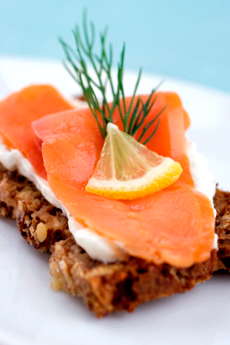
A favorite form of a favorite fish: smoked salmon. Photo by Kelly Cline | IST.
|
|
This glossary was compiled by THE NIBBLE EDITORS. It is updated regularly.
|
|
October 2005
Last Updated April 2017 |

|
Fish & Seafood Glossary
Page 11: Seafood Types Beginning With S
This is Page 11 of a 13-page glossary featuring different types of fish and seafood. Here, seafood types beginning with S, such as salmon, sardine, scallop and shrimp. Click on the links below to visit other pages. See our many other food glossaries, each featuring a different favorite food.
Click on a letter to get to the appropriate page.
This glossary is protected by copyright and cannot be reproduced in whole or part.
You are welcome to link to it.
SABLEFISH
SALMON
While wild salmon are caught in North America, northern Europe and elsewhere, much of today’s salmon supply is farmed. Atlantic salmon are farmed around the world and account for more than 95% of all the pen-raised salmon (the remainder is Cohoe), and five large companies produce half the world’s farmed salmon. (It takes about 30 to 36 months to raise an Atlantic salmon from an egg to a market size of about 10 pounds.) While farming makes salmon accessible to more people, it does not produce as fine a product as wild salmon: Fish live in tanks with their own waste instead of flowing streams and rivers, and are fed antibiotics. A synthetic carotenoid pigment is added to their feed to achieve the reddish-orange color that wild salmon get naturally from eating carotenoid-rich shrimp and other natural feed. In addition to the Atlantic salmon:
-
Cohoes or “silvers” are the middle-of-the-road salmon. The resource isn’t that big, and though it can be an excellent eating fish, it’s not as highly regarded as a king or a sockeye salmon. Seventy percent of world production is farmed. They weigh 2 to 12 pounds.
-
Keta or Chum salmon have an excellent texture, attractive meat color and a lower oil content that helps to give them a mild, delicate flavor. This species is the meatiest with the firmest texture of the wild salmon. Most weigh from 4 to 13 pounds.
|
|

Atlantic salmon. |

Cohoe or silver salmon: farmed, middle-of-the-road. |

Keta or chum salmon: meatiest wild salmon. |

King salmon: the biggest and most prized. |

Pink Salmon: the largest volume. |

Sockeye salmon: the "red salmon” money crop of wild salmon. All photos courtesy of PacSeafood.com. |
-
King salmon, a.k.a. Chinook, are the largest and most prized of the wild salmon: big, silvery, fighting fish, with a rich red meat. They’re the largest and scarcest of the five species of Alaska salmon, prized for their color, high oil content, firm texture and succulent flesh. With the highest amounts of omega-3s of all Alaskan salmon, they are considered to be the richest salmon in
the world.They are found on the eastern North Pacific, from the Yukon River in Alaska to the Sacramento River in central California. The most famous and highly-prized for their fat marbling are Alaska’s Copper River salmon, along with the Copper River sockeye, which are the first major variety of wild salmon to come to market each year (the Copper River empties into the Gulf of Alaska—the season begins May 14 and lasts a month). It has more fats than other species, providing more flavor. King salmon typically weigh from 5 to 40 pounds, but can exceed 100 pounds. They are Alaska’s state fish.
-
Pink salmon are the largest in volume (200 million return to the rivers and streams of North America in good summer). In terms of size, though, pinks are the smallest of the five species of Pacific salmon, averaging just 3 pounds.
-
Sockeye salmon are the money fish in the wild salmon business, considered the most flavorful of the Pacific salmkon, with the reddest flesh and highest level of omega-3 essential fatty acids. They weigh up to 15 pounds. Alaska produces more than 75% of the world's sockeye harvest. About 60% of the North American harvest is exported to Japan and 30% is canned for domestic consumption.
Note that the thinner, sloping portion of the fillet contains more fat marbling and is therefore more flavorful than the thicker portion.
SARDINE
A small, young, saltwater fish with soft edible bones, found in the Mediterranean. There are other small, young saltwater fish found that are called sardines, such as the Pacific and Atlantic herring, blueback herring and sprat, but they are not true sardines. The sardine is a silver color and has a rich flavored flesh that is dark colored. Fresh sardines should be put on ice immediately and eaten as soon as possible, but in the U.S., they are often hard to find fresh. |
|
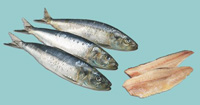
Sardines. Photo courtesy BCSeafoodonline.com. |
They are generally found canned in olive oil, soy oil or water. Sardines are popular as an appetizer and are good broiled or grilled.
SCALLOP
| A very popular bivalve mollusk with matching fan-shaped shells frequently used in dishes such as the famous Coquilles St. Jacques. There are hundreds of species of scallops around the world, but three of them dominate scallop sales in the U.S.: North Atlantic sea scallops, bay scallops and the Japanese sea scallop. The most common portion eaten in the U.S. is the round adductor muscle, the disc-shaped white meat which connects a scallop's tissue to its shell. In most other countries, however, scallops are eaten with the roe attached to the adductor meat. Live scallops, which are eaten whole like clams or oysters, are also increasingly popular.
-
Bay scallops are usually found on the East Coast, and are quite small, the muscle reaching only 1/2 inch or so wide. They are sweeter than the sea scallop. They're also less common and so more expensive than the sea scallop. Bay scallops typically run 80-120 per pound.
-
The sea scallop’s muscle averages 1-1/2 inches across. North Atlantic sea scallops, which are harvested from Nova Scotia to Virginia, are the largest scallops sold in the U.S., averaging 10-40 count per pound. While almost as sweet as bay scallops, they are less tender.
-
There is also a tiny calico scallop, caught off the coast of Florida, which runs 150-250 per pound.
|
|
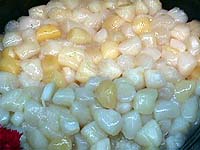 Bay scallops. Bay scallops.
|
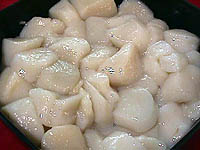
Sea scallops. Photos courtesy of PhilsFishMarket.com. |
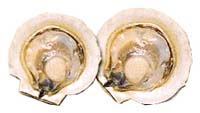
Photo courtesy of PacSeafood.com. |
Generally, the bigger the scallop, the more expensive it is. Fresh bay scallops are available on the East Coast in the fall, whereas fresh sea scallops are best mid-fall to mid-spring.
SCROD
A young codfish, which is a round saltwater fish. Its meat has a tender, flaky texture with a mild flavor. Scrod can be prepared using several methods, such as baking, steaming, broiling and poaching. Halibut or haddock can be substituted.
|
|
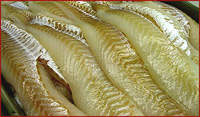
Photo courtesy of LobstersLive.com. |
SEA BASS or CHILEAN SEA BASS or MERO or PATAGONIAN TOOTHFISH
A round saltwater fish whose flesh has a firm white flesh, flaky texture and rich, oily flavor—putting it in great demand in the U.S., Japan and China. The name “Chilean sea bass” stems from the fact the fish was first commercially harvested in Chilean waters, and a more attractive marketing name was sought than its actual name, Patagonian toothfish—a unique species and not a bass at all.
|
|

Photo courtesy of PacSeafood.com. |
Now, however, sea bass are also fished off the coasts of Argentina, South Africa and Australia, plus assorted other waters in the southern latitudes. It can be cooked by broiling, baking, frying or steaming, and makes a good fish for cooking whole. If the fish has been properly cooked, the meat will appear opaque but will still be moist.
SEAFOOD
Any type of fish or shellfish that comes from the sea and is edible. |
SEA TROUT
SEA URCHIN
A sea animal that can grow up to 10 inches in diameter and consists of a hard shell that is covered by prickly spines, similar to a porcupine. The sea urchin is considered a delicacy in Japan, Korea and other Asian countries. It is mostly harvested for its eggs, which range in color from cream to orange.
SEVICHE
See ceviche. |
|
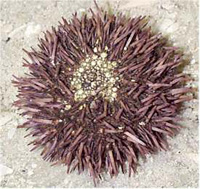
Photo courtesy of Seashells.org. |
SHAD
The largest member of the herring family, it has a slight oiliness and a mildly sweet flavor that resembles pompano and salmon. Shad is an anadromous fish, which means that it is born in freshwater, migrates to saltwater to mature, and then returns to freshwater to spawn. It is hard to fillet because of its many small bones, so it may be desirable to purchase one already filleted. |
|

American shad. Photo courtesy of ChartingNature.com. |
Otherwise, it can be steamed or baked at a low temperature for more than six hours, until the bones disintegrate. Female shad is more in demand than male because it is fatter and larger, and because it contains the desired roe.
SHELLFISH
A broad term for fish that have, or have had, a shell of some kind. The shell is a type of external skeleton that gives protection and structural support to the fish. Shellfish are divided into two basic categories based on the degree of shell hardness. Crustaceans have a shell-like exoskeleton—usually jointed. This group includes lobsters, spiny lobsters, crabs, shrimp, crayfish and barnacles. The second group, mollusks, has one or two harder shells or have moved beyond the need for a shell. They include the unipods (one shell—also called gastropods), such as the abalone, conch, snail and periwinkle; the bivalves (two shells), such as the clam, scallop, mussel and oyster; and the cephalopods (without shells), such as the octopus and the squid.
|
|
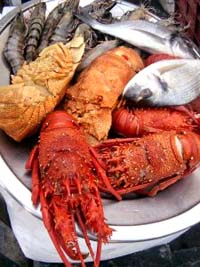
Shellfish platter—with a couple of gilled friends. |
SHRIMP
A very popular, small crustacean-type shellfish which includes hundreds of species worldwide. Shrimp is by far America’s favorite shellfish. While there are hundreds of different species of crustacean, most can be divided into either warm-water or cold-water shrimp. Generally, the small shrimp come from cold water, and large from warm water. Regardless, they are marketed by size, which varies by region, and sometimes by merchant.
- In various places, they are called by the number there are per pound, such as 21-30‘s (21-30 shrimp per pound) or U 10s (10 or less per pound); or by names such as colossal (10 or less/lb), jumbo (11-15/lb), extra-large (16-20/lb), large (21-30/lb), medium (31-35/lb), small (36-45/lb) and miniature (100 or so/lb).
- The smallest are also called popcorn shrimp.
- In the U.S., jumbo and colossal shrimp are commonly called prawns. While there are slight differences in texture and flavor, size is the main difference.
|
|
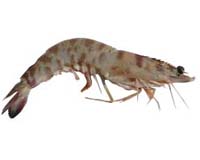 |
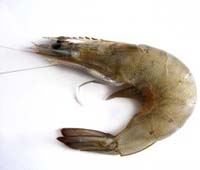
Photos courtesy of Sxc. |
Shrimp are available year-round, and can be found in many forms—shelled or unshelled, raw or cooked, fresh or frozen. There are also various shrimp products, such as breaded or stuffed shrimp, shrimp spread, dried shrimp and shrimp paste (see below). Contrary to popular belief, deveining a shrimp is not a safety, but a cosmetic issue. In larger shrimp, the vein might contain grit, so this becomes both a cosmetic and texture issue. Although warm water shrimp are often named by color (e.g., brown, white, pink), all can vary considerably in shading. To tell the difference with shell-on product, feel for a groove or ridge running the length of the shrimp’s carapace. If it’s there, the shrimp is a brown or pink; if not, it’s a white. (All three, of course, cook up pink.)
SHRIMP PASTE
An Asian paste made from grinding fermented shrimp and salt together, which may be dried to be shaped into cakes or kept in a soft, paste form. Made from shrimp meat that is either ground and salted or with meat placed whole in jars where it is allowed to ferment, shrimp paste has a very strong aroma and provides a very salty, fishy flavor when used in foods. It ranges in color from grayish-pink to brownish and is used sparingly in Asian soups, sauces, curries, marinades and rice dishes so it does not overpower the flavor of the main ingredients being prepared. |
SKATE
A saltwater fish found in temperate waters throughout the world. It is part of the ray family and is related to the shark. Skate has a flat body with triangle shaped wings on each side of its body. The wings are the edible part of the fish and are boneless. The meat of the skate has a mild, sweet flavor with a gelatin-like texture. If not available, catfish, shark or sturgeon can be substituted.
|
|
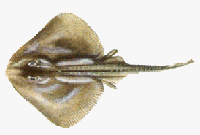 |
SMOKED FISH
Fish fillets that have been cured with smoldering, aromatic wood. The smoke from the burning wood gives the fish a distinctive smoky flavor and scent. Trout, salmon, herring, cod and mackerel are some of the fish that are popular choices for smoking. Smoked fish is sold in fish markets and some supermarkets.
|
|
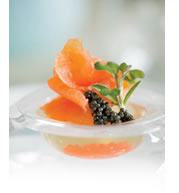
Photo of smoked salmon and caviar courtesy of TsarNicoulai.com. |
SNAIL or ESCARGOT
A univalve mollusk with a spiral shell. Escargot is the French word for snail. Of the various varieties, the vineyard snail, which feeds on grape leaves, is considered the best eating; but it grows slowly and is difficult to raise. It has a dull, yellowish-brown streaked shell with a blotchy flesh, and grows to approximately 1- 1/2 to 1-3/4 inches in size. The French petit-gris is a smaller variety, growing to about 1 inch, and is currently grown in the United States. |
|
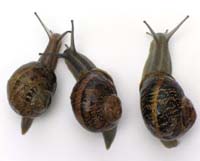
Photo courtesy of Sxc. |
Its shell and flesh are brownish-gray in color. Fresh snails can be found in specialty markets throughout the year and are generally boiled first and then baked or broiled in the shell. Canned and packaged snail shells are also available in many supermarkets.
SNOW CRAB
This crustacean, also known as the Queen Crab or Spider Crab, is harvested in the cold waters off Canada’s North Atlantic coasts. Whole legs can be found frozen, as well as the meat, pulled from the shells, in many food stores. The meat is mild and sweet, with a firm texture. Orangey-pink on the surface and white inside, the crabmeat is composed of fine filaments. Whole legs are cooked in a variety of ways, including steaming, and served with drawn butter. The removed meat is usually served cool, in salads or added to a variety of dishes. It is the inspiration for the dyed, whitefish based mock-crabmeat (surimi).
|
|
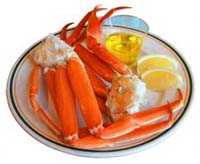
Alaskan Snow Crab. Photo courtesy of
Sxc. |
SOFT-SHELL CRAB
One of the two primary classifications of clam, the other being hard-shell. The shell is not correctly soft, but rather thin and brittle. These clams can't completely close because of a long neck (also called a siphon) that extends beyond its shell, hence why they are also called long-neck clams. On the East Coast, the steamer is the most common (also called Ipswitch clam). On the west coast, it’s the razor, and in Washington, the geoduck. |
|
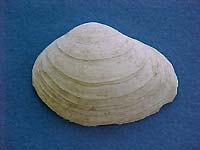
Photo courtesy Edmonds Discovery Programs. |
SOFT-SHELL CRAB
| Not a crab per se, but a time in a crab’s life. In order for a crab to grow larger, it must periodically shed its old shell (molt). Following this molting, the crab’s new shell is extremely soft and for a few days, it is a soft-shell crab. In the U.S., the blue crab is the most commonly eaten “soft-shell” crab. They are graded by size, with “jumbo” being the largest and most sought-after. See also crab.
|
|
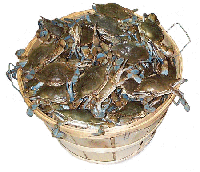
Photo courtesy of LintonSeafood.com. |
SOLE
True soles belong to the Soleidae family. The highest value sole, the true Dover sole, Solea solea, is fished in the eastern North Atlantic off Europe. Small quantities of true Dover are exported to white tablecloth restaurants in the U.S., primarily on the East Coast. The popular Dover sole, Microstomus pacificus, which is fished off the West Coast and Alaska, is a flounder that sells for considerably less than its European namesake. Dover sole is the most common flounder sold on the West Coast. Although Dover can reach 10 pounds in size, most are 1 to 1-1/2 pounds.
|
|
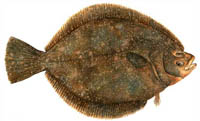
Rock Sole photo courtesy of ChartingNature.com. |
SPINY LOBSTER or ROCK LOBSTER
Spiny lobsters provide what most consumers buy as “lobster tails”—a big tail, bursting with meat. “Spiny lobster” and “rock lobster” are interchangeable terms. Both refer to some 40 species of clawless lobster found around the world. They generally range from 1 to 5 pounds, but can grow to 15 pounds. The vast majority of spiny lobster sold in the U.S. is sold as frozen tails, although much of the world harvest is sold live to Asian markets. Spiny lobster are marketed as either warmwater or coldwater, with the latter getting a premium because of their preferred flavor, texture and reputation for superior processing.
|
|
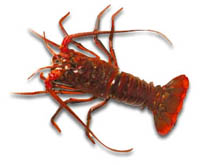
Spiny Lobster. Photo courtesy of PacSeafood.com. The female releases more than 700,000 eggs. |
SQUID or CALAMARI
Also called by its Italian name, calamari, this cephalopod has ten arms and is related to both the octopus and cuttlefish. Squid are mollusks, just like clams, mussels and oysters. The difference is squid have an internal shell, which is called a pen. Squid can usually be found from 2 to 3 inches long up to 10 inches.
|
|

Photo courtesy of PacSeafood.com. |
Although almost a hundred species of squid are fished commercially, two species, the Japanese flying squid and the Argentine shortfin squid, account for over half the world harvest. Squid is the second most widely consumed shellfish in the world but is more popular in Asian and Mediterranean cuisines than in U.S., with the exception of fried calamari, a staple appetizer at many restaurants, and in sushi. As with octopus, the ink can be used to color or flavor dishes such as Black Pasta or Calamares en su Tinta (“squid in their ink”). |
STONE CRAB
A very popular crab from the American south, its name comes from its stone-like, oval shell. Only the claws are eaten, and they are harvested by simply twisting off one claw and releasing the crab to grow a new one. This re-growth can take 1 or 2 years. The female crabs are not allowed to be de-clawed. In Florida, where most Stone crabs are harvested, the season runs from October 15th to May 15th. The claws are sold precooked and frozen to prevent the meat from sticking to the shell. It’s sold by size, with Jumbo being the largest typically available—around 1/3 of a pound a claw. It’s traditionally served cooked, chilled, cracked and with mustard sauce.
|
|
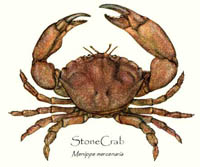
Photo courtesy of ChartingNature.com. |
STRIPED BASS or ROCKFISH
A lean saltwater fish with flesh that is tender, white and mildly sweet. The striped bass is a saltwater fish that migrates to fresh water to spawn. It is a versatile fish that can be prepared in many ways, but when grilling, it is best to place the fish in a basket because it does not hold together well. Trout, grouper, snapper or monkfish can be used for substitutes if striped bass is not available. To check the fish for doneness, use the tip of a sharp knife and cut through the thickest part of the fillet. If the fish has been properly cooked, the meat will appear opaque, but will still be moist.
|
|

Photo courtesy of ChartingNature.com. |
STURGEON
An anadromous fish, meaning it matures in saltwater, but migrates to fresh water to spawn. It averages in weight at 55 to 60 pounds, but some specimens grow much larger. The fish roe from the sturgeon is considered the “true caviar” and is probably more important than its flesh. The sturgeon has a rich, high fat flesh that is very firm, similar to meat, and is delicately flavored. On a limited basis, fresh sturgeon is available whole (less than 8 pounds), or cut into steaks or chunks. Most of the sturgeon caught in U.S. waters is smoked. |
|

Atlantic Sturgeon photo courtesy of ChartingNature.com. |
SUNFISH
A North American freshwater fish, which consists of many varieties that are noted for their unique shapes and brilliant colors. The varieties include white and black crappies, and several types of bass, such as largemouth, smallmouth, redeye, rock and spotted. |
SURIMI
Surimi is the deboned, minced and washed flesh from pollack, whiting and other fish that is formed and flavored into seafood analogs that look and taste as much as possible like high-value shellfish. A Japanese export, the most familiar to U.S. audiences is simulated crab, called kaneboko in Japan and “sea leg” in the U.S. (hundreds of different surimi products are consumed in Japan). The Japanese have been turning fish into surimi for hundreds of years, originally so fisherman could preserve their excess catches. Each year, the average Japanese person eats 15 pounds of surimi seafoods—an amount equal to all the seafood consumed annually by the average American.
|
|
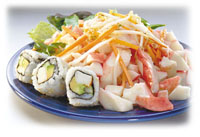
Surimi made into “crab salad” and served with a California Roll. |
SWORDFISH
The firm, juicy white meat of swordfish is a favorite of chefs in the U.S., the world’s largest single market for swordfish. A big, voracious predator, swordfish can exceed 1,000 pounds. With a thick, meaty texture and full flavor, swordfish can be served simply or with fresh herbs, marinades or salsas. Perfect for high-heat cooking methods such as grilling and broiling, swordfish can also be baked with excellent results. The key is cooking swordfish quickly, so it retains its moisture and doesn’t dry out. Although the U.S. is a major market for swordfish, American fishermen catch just 5% of the annual worldwide swordfish catch. Japan is the world’s leading producer, followed by Taiwan. |
|

Photo courtesy of PacSeafood.com. |
© Copyright Lifestyle Direct, Inc. All rights reserved. Images are the copyright of their respective owners.

|
































